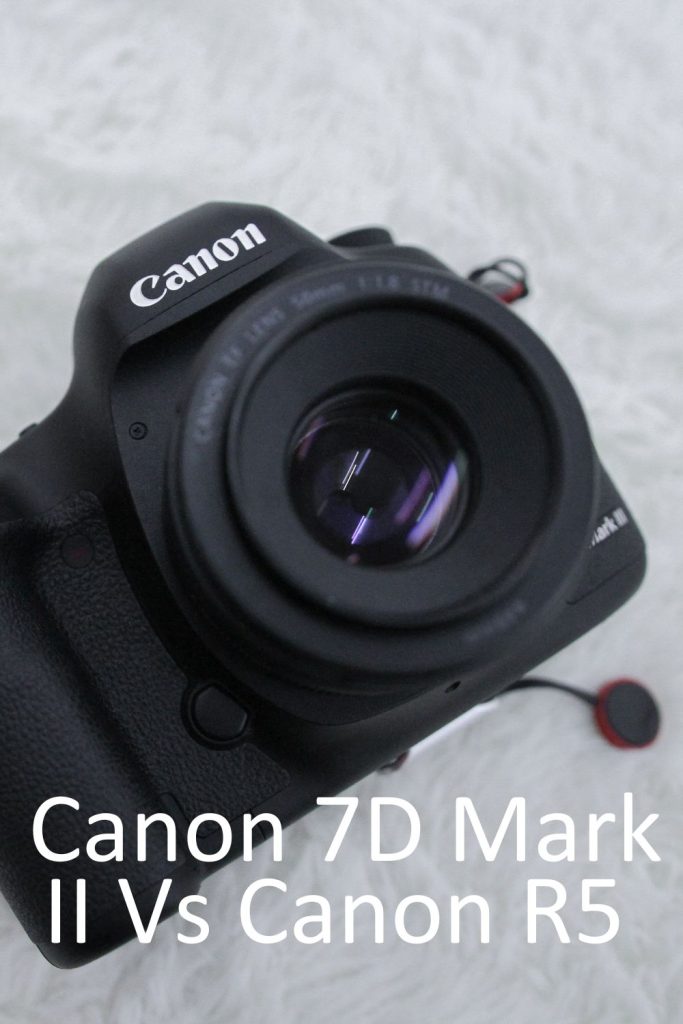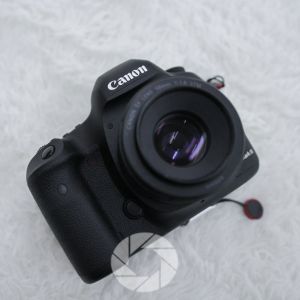
If you’ve been shooting landscapes on the Canon 7D Mark II, chances are you’ve heard the siren call of Canon’s mirrorless flagship: the R5.
On paper, it’s a massive leap with higher resolution, better autofocus, in-body stabilization, and cutting-edge video features.
But paper specs don’t always tell the whole story, especially when you’re weighing a trusted DSLR against a newer, more expensive system.
In this post, we’ll break down Canon 7D Mark II versus Canon R5 across the factors that matter most to photographers: image quality, autofocus, stabilization, video, viewfinders, lenses, and file handling.
I’ll share how each camera feels in the field, especially when chasing sunrise light in the desert, fog in the mountains, or reflections on alpine lakes.
I receive a small commission from links in this post, thank you for your support
Canon 7D Mark II vs Canon R5 Image Quality
The 7D Mark II is built around a 20.2-megapixel APS-C sensor, while the Canon R5 carries a full-frame 45-megapixel sensor. I found that to make a huge difference in my image quality.
Resolution: The R5’s files give you more room to crop without sacrificing detail, which is invaluable for distant wildlife or expansive landscapes.
Dynamic range: Shooting into sunrise or sunset, the R5 recovers highlights and shadows with far less noise. The 7D Mark II often struggles in these extremes, especially when lifting shadows in post. Because I emphasize contrast in my photography, the R5 made a spectacular difference in my images. The expanded dynamic range gave me artistic license to experiment more and embrace the vision.
Low light: The R5’s larger pixels and full-frame sensor handle higher ISOs gracefully, opening creative doors for twilight landscapes or astrophotography. The 7D Mark II could not keep up with the technical demands I was placing on it, becoming hot during shoots.
Discover Your Next Journey – These Tours are designed for people who connect with light and landscape.
Canon 7D Mark II vs Canon R5 Autofocus
Autofocus is one of the biggest leaps forward.
7D Mark II is known for its 65 cross-type AF points and speed, it was a favorite among sports and wildlife shooters. But it relies on traditional phase-detect AF through the optical viewfinder, with limited tracking in live view.
With Dual Pixel CMOS AF II, 1053 focus points, and advanced tracking for eyes (human and animal), the R5 practically glues itself to moving subjects. Birds in flight, deer crossing a meadow, or even hikers in fog; all stay sharp.
Canon 7D Mark II vs Canon R5: Quick Comparison
| Feature | Canon 7D Mark II | Canon R5 | Real-World Notes |
|---|---|---|---|
| Sensor | 20.2 MP APS-C | 45 MP Full-Frame | R5 doubles resolution + dynamic range; more crop flexibility. |
| Image Quality | Good in daylight; struggles in shadows/high ISO | Excellent across light conditions | R5 excels in low light and sunrise/sunset tones. |
| Autofocus | 65-point AF (OVF); limited live view | Dual Pixel CMOS AF II; Eye/Animal AF | R5 tracks birds, wildlife, and people effortlessly. |
| Stabilization | None (lens-based only) | In-Body Image Stabilization (up to 8 stops) | R5 smooths handheld landscapes + long exposures. |
| Video | 1080p/60 fps | 8K RAW, 4K/120 fps | R5 opens hybrid photo/video possibilities. |
| Viewfinder | Optical (OVF) | Electronic (EVF, 5.76M dots) | OVF = natural feel; EVF = real-time preview of exposure/white balance. |
| Lenses | EF/EF-S | RF (with EF adapter support) | RF glass is outstanding but expensive; adapters work seamlessly. |
| File Sizes | Small, easy to store/edit | Large RAWs; storage + computer upgrades needed | R5 demands faster workflow + bigger cards/drives. |
| Wildlife Reach | Crop factor (1.6x) gives telephoto advantage | Full-frame, but higher res allows cropping | 7D Mark II still has reach appeal with long telephotos. |
| Price (Body Only) | Discontinued; used ~$500–$800 | ~$3,400 new | R5 is a major investment; worth it if you need its features. |
Canon 7D Mark II vs Canon R5 Stabilization
Another huge difference: the R5 has in-body image stabilization (IBIS) rated up to 8 stops when paired with certain lenses.
- 7D Mark II: Stabilization depends entirely on lens choice. With longer telephotos, shake is a constant challenge, especially when handholding.
- R5: Even with wide-angle primes, IBIS helps smooth out handheld shots at dawn or twilight. For long exposures of waterfalls or reflective lakes, it feels like cheating but in a good way.
📸Learn for free!
➡️ FREE Wallpapers and Guides
➡️ DISCOUNTS on future Tours & Tutorials
➡️ TIPS for improving Your photography

I don’t share your Info with anyone. You can unsubscribe at anytime.
Canon 7D Mark II OVF vs Canon R5 EVF
This is a matter of personal preference.
- 7D Mark II: Optical viewfinder (OVF) is bright, clear, and lag-free. Many photographers love the “direct” connection with the scene.
- R5: Electronic viewfinder (EVF) previews exposure, white balance, and depth of field in real time. At first, it feels less natural than an OVF, but it drastically reduces guesswork.
Canon 7D Mark II vs Canon R5 Lenses
This is where practical considerations come in.
- 7D Mark II: Uses EF-S and EF lenses, with decades of options. Many 7D shooters have built large EF kit bags.
- R5: Native RF lenses are superb; sharp, fast, and optimized for mirrorless, but also large and expensive. You can adapt EF lenses seamlessly, but EF-S lenses crop heavily and I wouldn’t recommend them.
If you’re invested in EF glass, adapting is a cost-effective bridge. But if you’re building from scratch, RF lenses unlock the R5’s potential.
Canon 7D Mark II vs Canon R5 File Sizes
A practical but often overlooked detail:
- 7D Mark II: Smaller RAW files (20 MP) are easier on storage and editing software.
- R5: 45 MP RAWs are big. You’ll need faster cards, bigger drives, and a more powerful computer for smooth editing. Additionally, depending on your software, you may need to download additional apps as the CR3 format of the R5 files can’t be read by Windows
If you shoot heavily for example multi-day landscape trips or long wildlife bursts, this difference matters. With the R5, careful file management becomes part of your workflow.
I had to purchase much large Memory cards (250GB) plus I have to ensure they were lighting fast to be able to process continuous shooting mode and intervals for astro.
My Beef with Canon’s Mirrorless Line up
The slow release of lenses and overall lack of lenses. Canon also seems unwilling to share their specs with third party lens manufacturers like Sigma, leaving astrophotographers to use their older EF lenses with adapters.
Seasonal Perspectives: Shooting with Both Cameras
Thinking in seasonal cycles highlights how each camera performs.
- Winter: The R5 manages bright snow highlights with ease. The 7D Mark II often underexposes, requiring compensation.
- Spring: Misty mornings highlight the R5’s dynamic range. The 7D Mark II struggles to capture subtle tonal shifts in haze.
- Summer: Both perform well in strong daylight, but the R5 retains more detail in harsh contrast.
- Autumn: The R5’s color depth shines in saturated foliage, while the 7D Mark II can feel flat in comparison.
Conclusion
So where does that leave us in the Canon 7D Mark II versus Canon R5 debate?
If you’re happy with daylight landscapes, smaller files, and EF glass, the 7D Mark II remains a capable companion.
If you crave higher resolution, better low-light performance, IBIS, advanced autofocus, and hybrid video/photo capability, the R5 is a transformative upgrade.
📸Learn for free!
➡️ FREE Wallpapers and Guides
➡️ DISCOUNTS on future Tours & Tutorials
➡️ TIPS for improving Your photography

I don’t share your Info with anyone. You can unsubscribe at anytime.
- Canon 7D Mark II vs Canon R5 Image Quality
- Canon 7D Mark II vs Canon R5 Autofocus
- Canon 7D Mark II vs Canon R5: Quick Comparison
- Canon 7D Mark II vs Canon R5 Stabilization
- Canon 7D Mark II OVF vs Canon R5 EVF
- Canon 7D Mark II vs Canon R5 Lenses
- Canon 7D Mark II vs Canon R5 File Sizes
- My Beef with Canon's Mirrorless Line up
- Seasonal Perspectives: Shooting with Both Cameras
- Conclusion
- FAQs: Should I Upgrade?
- 📸Learn for free!
- 📸Learn for free!
FAQs: Should I Upgrade?
Should I upgrade from Canon 7D Mark II to Canon R5?
If you prioritize image quality, autofocus, and creative flexibility, yes. But weigh cost, file size demands, and whether you’re ready to invest in RF glass.
Canon 7D Mark II vs Canon R5 for landscape photography?
The R5 is a clear winner for dynamic range, resolution, and stabilization. However, the 7D Mark II still holds up for daylight landscapes if you’re not printing large.
Canon 7D Mark II vs Canon R5 for wildlife photography?
The R5’s eye-tracking and fast burst rates give it a massive edge. But paired with a long EF telephoto, the 7D Mark II’s APS-C crop factor still has reach advantages.
Canon 7D Mark II vs Canon R5 low light performance?
No contest—the R5 excels in twilight, nightscapes, and astrophotography. The 7D Mark II falls short in high-ISO situations.






